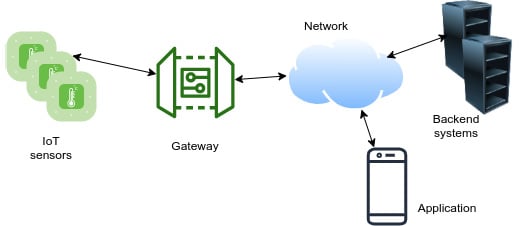Understanding the basic structure of IoT solutions
An IoT solution combines many different technologies into a single product, starting from a physical device and covering all layers up to end user applications. Each layer of the solution aims to implement the same vision set by the business, but requires a different approach while designing and developing. We definitely cannot talk about one-size-fits-all solutions in IoT projects, but we still can apply an organized approach to develop products. Let's see which layers a solution has in a typical IoT product:
- Device hardware: Every IoT project requires hardware with a System-On-Chip (SoC) or Microcontroller Unit (MCU) and sensors/actuators to interact with the physical world. In addition to that, every IoT device is connected, so we need to select the optimal communication medium, such as wired or wireless. Power management is also another consideration under this category.
- Device firmware: We need to develop device firmware to run on the SoC in order to fulfill the project's requirements. This is where we collect data and transfer it to the other components in the solution.
- Communication: Connectivity issues are handled in this category of the solution architecture. The physical medium selection corresponds to one part of the solution, but we still need to decide on the protocol between devices as a common language for sharing data. Some protocols may provide a whole stack of communication by defining both the physical medium up to the application layer. If this is the case, you don't need to worry about anything else, but if your stack leaves the context management at the application layer up to you, then it is time to decide on what IoT protocol to use.
- Backend system: This is the backbone of the solution. All data is collected on the backend system and provides the management, monitoring, and integration capabilities of the product. Backend systems can be implemented on on-premises hardware or cloud providers, again depending on the project requirements. Moreover, this is where IoT encounters other disruptive technologies. You can apply big data analytics to extract deeper information from data coming from sensors, or you can use AI algorithms to feed your system with more smart features, such as anomaly detection or predictive maintenance.
- End user applications: You will very likely require an interface for your end users to let them access the functionality. 10 years ago, we were only talking about desktop, web, or mobile applications. But today we have voice assistants. You can think of them as a modern interface for human interaction, and it might be a good idea to add voice assistant integration as a feature, especially in the consumer segment.
The following diagram depicts the general structure of IoT solutions:

Figure 1.1 – Basic structure
This is the list of aspects, more or less, that we need to take into account in many types of IoT projects before starting.
IoT security
One important consideration that remains is security. Actually, it is all about security. I cannot overemphasize its importance whatever I write. IoT devices are connected to the real world and any security incident has the potential for serious damage in the immediate environment, let alone other cybersecurity crimes. Therefore, it should always be in your checklist while designing any hardware or software components of the solution. Although security, as a subject, definitely deserves a book by itself, I can list some golden rules for devices in the field:
- Always look to reduce the attack surface for both hardware and firmware.
- Prevent physical tampering wherever possible. No physical port should be open if this is not necessary.
- Keep secret keys on a secure medium.
- Implement secure boot, secure firmware updates, and encrypted communication.
- Do not use default passwords; TCP/IP ports should not be open unnecessarily.
- Put health check mechanisms in place along with anomaly detection where possible.
We should embrace secure design principles in general as IoT developers. Since an IoT product has many different components, end-to-end security becomes the crucial point while designing the product. A risk impact analysis should be done for each component to decide on the security levels of data in transit and data at rest. There are many national/international institutions and organizations that provide standards, guidelines, and best practices regarding cybersecurity. One of these, which works specifically on IoT technology is the IoT Security Foundation. They are actively developing guidelines and frameworks on the subject and publishing many of those guidelines, which are freely available.
Important note
If you want to check those guidelines, you can visit the IoT Security Foundation website for their publications here: https://www.iotsecurityfoundation.org/best-practice-guidelines/.
Now, that we are equipped with sufficient knowledge of IoT and its applications, we can propel our journey with ESP32, a platform perfectly suited for beginner-level projects as well as end products. In the remaining sections of this chapter, we are going to talk about the ESP32 hardware, development frameworks, and RTOS options available on the market.




























































